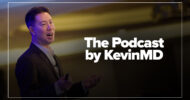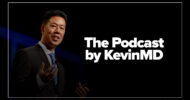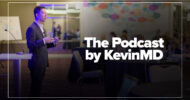Subscribe to The Podcast by KevinMD. Watch on YouTube. Catch up on old episodes!
Physician executive Steven Lane discusses his article, “Why interoperability is key to achieving the quintuple aim in health care.” He explains that true interoperability is not just about technology but about aligning people, processes, and IT systems to allow patient information to flow seamlessly across all members of a care team. Steven argues that interoperability is one of the few factors in health care that can positively influence all five goals of the Quintuple Aim. He details how connected data leads to a better patient experience, improved clinical outcomes, lower costs, greater provider satisfaction, and better health equity. The conversation highlights that technology alone isn’t a silver bullet; real progress depends on educating clinicians on how to use available data exchange tools and fostering a collaborative mindset. By embracing its full potential, interoperability can become a foundational element of a more modern, efficient, and equitable health care system.
Careers by KevinMD is your gateway to health care success. We connect you with real-time, exclusive resources like job boards, news updates, and salary insights, all tailored for health care professionals. With expertise in uniting top talent and leading employers across the nation’s largest health care hiring network, we’re your partner in shaping health care’s future. Fulfill your health care journey at KevinMD.com/careers.
VISIT SPONSOR → https://kevinmd.com/careers
Discovering disability insurance? Pattern understands your concerns. Over 20,000 doctors trust us for straightforward, affordable coverage. We handle everything from quotes to paperwork. Say goodbye to insurance stress – visit Pattern today at KevinMD.com/pattern.
VISIT SPONSOR → https://kevinmd.com/pattern
SUBSCRIBE TO THE PODCAST → https://www.kevinmd.com/podcast
RECOMMENDED BY KEVINMD → https://www.kevinmd.com/recommended
Transcript
Kevin Pho: Hi, and welcome to the show. Subscribe at KevinMD.com/podcast. Today we welcome Steven Lane. He’s a physician executive. Today’s KevinMD article is “Why interoperability is key to achieving the Quintuple Aim in health care.” Steven, welcome to the show.
Steven Lane: Thank you, Kevin. It’s great to be here. And I love the title that you chose because that’s something I like to talk about.
Kevin Pho: All right, so just briefly share your story and then jump into the KevinMD article that you wrote for us.
Steven Lane: Sure. So, I am a practicing family physician for 35 years or so. I have been a clinical informaticist pretty much all that time. I started using electronic medical records as an ER doc at Kaiser in San Francisco back in the late 1980s and really, very early on, saw the value of digitizing health information. Fast forward, I’ve had an entire career of both being a practicing doc and a clinical informaticist, and it’s been very exciting.
The focus initially was on implementing EHRs, rolling them out, optimizing them, and then, when we got to the point in EHR implementation where you were just dealing with trying to get people to comply and use the tools, I transitioned about 15 years ago to interoperability, which was kind of a new thing then. Interoperability has kept me very busy for the past 15 years. I’ve had a chance to work throughout the industry, working with regional HIEs, working with national networks, and building national frameworks.
Then a few years ago, I stopped my continuity primary care practice and dove in to be the chief medical officer at Health Gorilla, which was a startup health information network that now has become one of the qualified health information networks, or QHINs, helping to stand up and advance the nationwide Trusted Exchange Framework and Common Agreement, or TEFCA. The company also works locally in California, where I hail from, to support the data exchange framework that that state is trying to stand up.
I’ve just had a great opportunity over the course of my career to be involved in driving the national discussion of health information exchange, health data privacy, security, patient access, and a lot of really interesting things. So it’s been a blast, and I’m happy to be here to talk about it.
Kevin Pho: All right. Now, before talking about your article, for those who aren’t versed in the vernacular of health IT, give us a 30-second definition of what interoperability is, and then tell us why that’s so important as part of solving the so-called Quintuple Aim.
Steven Lane: Sure. So interoperability is simply the ability to exchange data to access data. Coming at it from a clinician’s perspective, it’s to access as much of the relevant data for a patient as you can in order to take the best care of that patient. And best, of course, in all the dimensions of that, which we can dive into.
If you think about it at a public level or a community level, it’s how do you take care of a population of patients? Either if you’re talking about trying to do that from a business efficiency perspective and value-based care or whether you’re talking about public health and trying to simply maintain the health of the entire population. All of that is really based on having access to information, which is now data about the individuals involved.
And if you come at it from the patient or the caregiver perspective, it’s a similar issue. As an individual, you want to be able to access your own data, you want to be able to understand that, to be able to utilize that, to be able to make a well-informed decision. So interoperability is a complex web of exchange purposes and participants. And we have been making advances in all of those complex relationships over the past 15 or 20 years. There’s much work left to be done, but again, I think the Quintuple Aim provides a nice framework for thinking about what’s the whole point of this, what are we trying to do, whether you go back to health information and data from the get-go or whether you’re talking about the exchange and utilization of that information.
Kevin Pho: And just to be sure, interoperability is much more than just simply one EHR talking to another, right?
Steven Lane: Well, that’s how it started, right? I mean, initially, we had intraoperability. You had a clinic or a health system, and it needed to hook up its own systems internally: billing, scheduling, clinical documentation, orders, results, et cetera. And then we realized, well, wait, it doesn’t all happen inside one clinic or one hospital or one health system.
My patients in Palo Alto, where I was practicing at the time, would go across the street to Stanford. And lo and behold, we were actually using the same EHR system. So we started by just trying to say, how do we move data back and forth, even within a single system? And then, of course, the larger challenge is how to do that in a vendor-agnostic way so that wherever an individual receives their care, the provider, the care team can have access to all the relevant data in a way that is truly useful.
Kevin Pho: And in terms of the Quintuple Aim, for those who aren’t familiar with that, what is it, and how can interoperability, of course, help us achieve those goals?
Steven Lane: Well, let me lay out what is the Quintuple Aim. It started as the Triple Aim. This was probably 10, 15 years ago. I don’t keep the date in my mind, but this was the Institute for Health Care Improvement, I think, and they said, hey, what are we actually trying to do in health care?
And what we’re trying to do is we’re trying to improve the health of the entire population. So that was the first aim: improve the health. And then we’ve got this challenge that health care is very expensive. So the second aim was to decrease the per capita cost of care at a nationwide or worldwide or population level.
And then the third aim that was proposed was we want to, we care about the individual’s experience, the patient experience in receiving that care. So that was the initial Triple Aim. It was cost, it was quality, and it was patient experience.
And then, a few years went by and another organization said, hey, we’ve got this problem of provider burnout, and clinicians, they have a role in all of this. And we should not only care about the patient or the caregiver, the patient caregiver—I’m using caregiver in the sense of the patient’s personal caregivers—we shouldn’t just be caring about their experience, but also about the care team, the provider’s experience, if you will. So that became the fourth aim. So there was a Quadruple Aim for a little while.
And then another group of people said, hey, what about health equity? We should really be driving towards equitable distribution of care, services of health, and all the components of that. So that was the birth of the Quintuple Aim. So cost and outcome, that’s value. Patient and care team experience, those are three and four. And then equity.
So when I think about the Quintuple Aim, it certainly aligns with how I act as a practicing physician and as a public health professional, as an informaticist, and as a health policy person. It’s like those are the things I want. I think that’s a really good way to think about what our goals are.
I think that health information, health data interoperability is the only tool I can think of that can simultaneously impact all five of those aims. There’s no medicine or surgery or business arrangement that simultaneously gets at all of those, but sharing and utilizing health information clearly impacts cost, quality, experience, and equity. So that was sort of where, how I frame that when I started talking about interoperability way back when.
It was the “rights”: getting the right information to the right individual at the right time, in the right format with the right supporting workflows. And I think that’s another way to think about this, but that’s sort of what you’re trying to build. And then the Quintuple Aim is what you’re trying to do with it.
Kevin Pho: Now in your article, you gave an example, and I want you to share that example because that really gives that practical illustration of how interoperability can address these Quadruple Aims.
Steven Lane: Yeah. So there are many examples of where access to health information can positively impact the care you provide. Certainly, you can think of any number of use cases. You can think of pregnancy and delivery and newborn care, where often those services are provided in different institutions with different health IT systems, and needing to move data from the prenatal setting to the labor and delivery setting to the newborn care setting and subsequent care is going to be critically important.
In my work today in primary care, what I’m doing mostly is acute primary care. So I’m seeing patients who have other continuity providers, but I’m seeing them because they can’t get in or they have an acute need. And so often that is in the context of a transition of care. Either somebody just got out of the hospital, or they’ve been seeing multiple doctors about a problem, or they need a follow-up and to be referred to another care setting. And there again, the ability to access the information when I see a patient who just got out of the hospital or was just prescribed a new medicine is critical to be able to see that information.
I think in medicine, we are so used to flying blind. For centuries, we have simply had the data that we had available to us, often filtered through the patient’s recollection and understanding of what’s been going on. We just got used to making the best decisions that we could. With interoperability and the digitization of health information, we really do have the opportunity to get that more fulsome picture. But with that opportunity comes the responsibility to be able to utilize the information, to actually look at it, to think about it, and to work through it.
And that’s really challenging. I mean, one of the challenges of EHRs was that it made physicians in particular, but also nurses and pharmacists and others, do more work. It’s very easy to just sort of scribble something on a piece of paper that nobody can read and go about your business. That was back in the day when you could see a patient every three to five minutes. And I’ve done that in disaster settings and in third-world settings, et cetera. But if you really want to take good care of people, you want to collect good data. And we learned early on that that interoperability and digitization of health information allowed us to do that with interoperability.
It’s also more work. The current state of the systems is not that everything comes together and is magically presented to a caregiver in a totally understandable way, in a lovely format, in a way that’s customized to their workflow or their specialty or their domain. It’s work, and I think it’s a reasonable complaint that these systems are not anywhere near perfect yet.
The other thing, you can’t talk about health information technology without talking about AI these days. AI holds the promise of taking some of that burden off of the clinical caregivers or the care team and being able to take that data, bring it into a location, allow an algorithm to work on it, and to elevate the key points: to summarize the chart, to identify actionable insights into the data in a way that we as human beings were never able to do initially and certainly can’t do now with the flood of information that we have made available through the digitization of data and the exchange of that information.
So it’s a time of great change. Some people who are comfortable with EHRs, with health information exchange, with accessing the data that is available and integrating it as best they can, given the capabilities of their system, I think people really get it. I mean, it makes me very excited every time I see patients. Other people see this as incredibly burdensome. You’re just throwing more data at me. I’m drowning in it. I can’t make any sense of it. I have to sort through a long document to find the little piece of data that I’m looking for, but I think we’re all learning that AI really does hold the promise of helping to mitigate some of those challenges.
Kevin Pho: You wrote in your article that a lot of software solutions are developed in isolation, so talk to us about a path forward in terms of promoting and really focusing on interoperability. What needs to happen going forward?
Steven Lane: I think a lot of this has been happening over the past decade or so, and that is the standardization of systems. As you mentioned, systems have been developed over decades now by very well-intentioned people doing the best they could with what they had. Right. I mean, you hear complaints from people saying, “Oh, I hate my EMR. It was clearly designed by a bunch of engineers for billing purposes.” I was in those rooms. That’s really not what happened. There were really clinicians and people who were very thoughtfully saying, how can we do this as well as we can?
But the history of the health IT industry is such that good ideas popped up in Wisconsin and in Kansas and in Boston and in different places. And people built the systems. And then there was this need to interoperate, and you need to have standards. You need to have technical standards and workflow standards in order to actually move the data and make it ingestible and utilizable at the point of care. And those standards have been evolving over the past 10 or 15 years: standards of how the data is formatted, standards of how it is exchanged. And it’s not just about the data itself, but it’s also about the processes. How do we do this in a way that is safe, that is secure, that respects privacy and gets the data where it needs to go?
I think doing more of what we’ve been doing, advancing the standards within—I’ve had an opportunity to work within Health and Human Services, HHS, and their Health Information Technology Advisory Committee, the HITAC, for a number of years. And that’s where a lot of work is done around what standards exist, how they are going to be embedded into rulemaking and into policy and into requirements. So there is a certification process for certain types of health information technology, especially electronic health records. There is likely to be an expansion of that, to be certification for the systems that are used in long-term and post-acute care, the systems that are used in pharmacies, the systems that are used by EMS providers.
A lot of this has been driven by the market, but of course, market forces have some perverse incentives where people end up trying to hold on to their intellectual property, hold on to their data for understandable reasons when you think about it from a business perspective. But what we need as a society is to have more standards to facilitate more transparent sharing of standardized information. Again, I think it’s happening.
And the more we have engagement from people who are clinicians, who are patient advocates, who are caregivers, but also who are payers, who are public health entities. And that’s what’s been happening over the past few years within the interoperability space, is looking at how to open the tent, how to bring in more people. We had a bunch of providers initially just saying, “How are we going to move data from this clinic to this hospital?” Right? Which was very important. And we’ve been tremendously successful with that. Billions of transactions every month occur through the established networks and frameworks that we’ve built across the country.
But clearly there’s a lot of unmet need: community-based social services, therapists in the community, complementary care providers, dentists, you name it, are out of the loop. So you can’t really provide comprehensive holistic care unless you have a comprehensive and holistic view of the information that is relevant to a patient.
Kevin Pho: We’re talking to Steven Lane. He’s a physician executive. Today’s KevinMD article is “Why interoperability is key to achieving the Quintuple Aim in health care.” Steven, let’s end with some take-home messages that you want to leave with the KevinMD audience.
Steven Lane: Well, I think really it is: pay attention to the data you create and the data you consume. Try to make sure that that data is clean because not only will you and the patient benefit, but everyone downstream who ends up caring for, touching, supporting this patient will have the opportunity to provide a better service if we have better information and make that available.
Kevin Pho: Steven, thank you so much for sharing your perspective and insight, and thanks again for coming on the show.
Steven Lane: My pleasure. Nice to talk to you.


























